When to plant family onions before winter and is it possible in the Urals
The family (aka multi-root) onion is loved by many gardeners for its ability to grow in groups, when several onions grow from one bulb. In early spring, he gives amicable shoots of useful juicy greens. To get juicy greens in early spring, you need to take care of this in the fall.
The content of the article
Is it possible to plant a family onion before winter
Plant it before winter you can and should. Planting crops before winter has a number of advantages over spring work: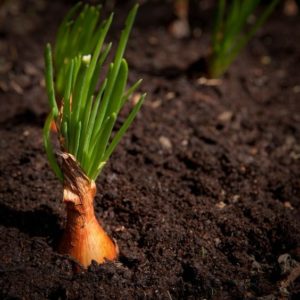
- the harvest of green feathers and turnips is obtained 25-30 days earlier;
- winter onions require minimal care;
- the heads grow larger;
- family winter onions are resistant to shooting, have good immunity to fungal infections;
- when the snow melts in spring, the heads receive the required amount of moisture, which contributes to their rapid growth.
When to plant family onions before winter
Planting crops in autumn is carried out 30-40 days before the establishment of stable frosts. Daytime temperature should be kept within 0 .. + 5 ° C, night temperature should not fall below -3 ° C.
Important! Sevok should have time to take root before the snow cover forms. With an earlier planting, the planting material can germinate and die under the snow.
Planting times vary by region.
In outskirts of Moscow
In the Moscow region, planting of culture is carried out in 10-20 days of October.
In the Urals
Climatic conditions Ural vary due to the length of the region. In the northern regions with harsh winters, the crop is planted at the end of September. In the regions of the middle Urals - in the second half of September - early October. In the southern Ural regions - from early to mid-October.
In Siberia
In Siberia, in conditions of early cold snap, severe frosts, bulbs are planted in the second half of September, using only frost-resistant varieties. The beds are covered with spruce branches for the winter.
In the Leningrad region
In the Leningrad Region, planting of family onions begins in early October and ends by the middle of the month.
Lunar calendar
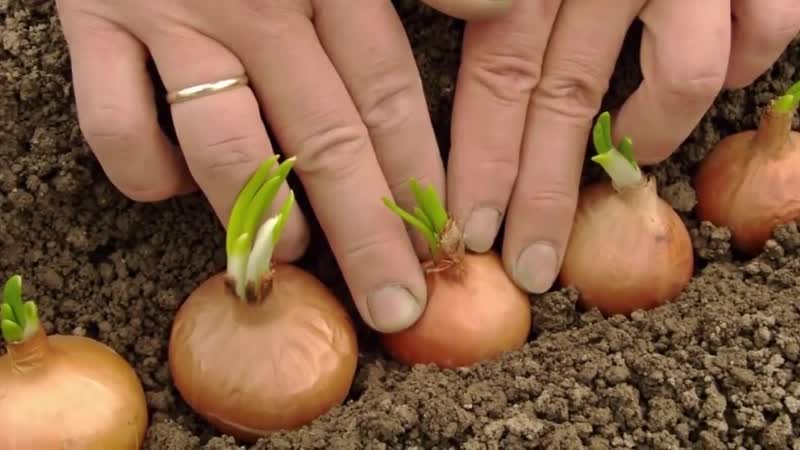
According to the lunar calendar, planting operations are carried out in the waning moon phase. For planting the culture, choose the "days of the Root" - the days on which the Moon is in the signs of Capricorn, Taurus, Virgo. It is believed that the Moon during this period has a beneficial effect on the growth and development of the underground part of plants (on the root system).
Reference! It is not recommended to plant onions on new and full moon days.
In the fall of 2020, the following days will be successful for planting winter onions:
- September: 11, 12, 13, 20, 21, 29, 30;
- October: 9, 10, 18, 26, 27.
Unsuccessful:
- September: 1, 2, 3, 16, 17, 18;
- October: 1, 2, 3, 15, 16, 17, 30, 31.
How to plant a family onion before winter
Before the start of autumn work, a suitable variety is chosen, planting material and beds are prepared. Before winter, they plant nigella or sevok. When choosing seeds, pay attention to the packing date. Expired seeds have low germination. With the correct sowing date, seedlings appear and take root before the onset of frost, which allows them to endure the winter period well.
Family onion varieties are suitable for winter planting: Strong, Ural purple, Earring, Guarantor, Sprint. All these varieties are frost-resistant, give 7-11 turnips from one set.
Soil preparation
For growing family onions, they choose a sunny site that is not located in low-lying areas. A month before the autumn work, the land is cleared of plant residues, dug deeply with the simultaneous introduction of organic matter, mineral fertilizers. For 1 sq. m make: 5 kg of humus, 300 g of wood ash, 50-70 g of superphosphate.
Attention! Before planting, check the acidity of the soil. With an increased rate, lime is introduced into the soil during digging.
Before landing the beds are slightly moisturized. This will allow the plants to quickly form a root system.
Preparation of planting material
The preparation of planting material is treated with special attention. They choose high-quality, healthy specimens, discarding damaged, sick ones. The selected material is disinfected in a solution of potassium permanganate (2 g per 10 l of water) for 30 minutes.
For better root formation, it is treated with the Epin growth stimulator for 20 minutes, heated in water with a temperature of +45 .. + 50 ° C for 15-20 minutes.
Selection of predecessors
To obtain high-quality healthy turnips, much attention is paid to predecessors. Winter onions are best planted after beets, carrots, cucumbers, radishes, courgettes, eggplants, tomatoes, legumes, corn, and other grains. Grows well after mustard, rapeseed.
It is not recommended to plant onions after potatoes, parsley, dill, beans, celery, garlic, clover. Onions after onions are planted no earlier than 4-5 years later. The use of the same site for planting onions for several years in a row will lead to an increase in the number of crop pests: onion flies, moths, hoverflies, weevils, stem nematodes.
Landing
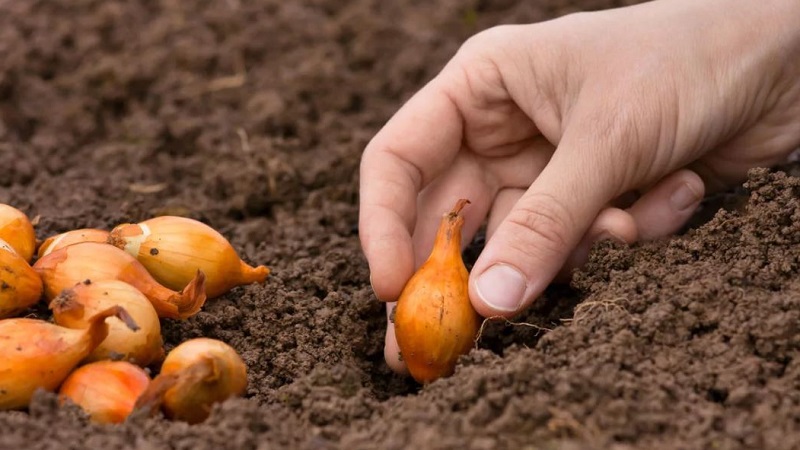
Family onions are planted in two ways: by sowing nigella and planting a set. Schemes, depth, planting rules depend on the choice of planting material.
Seeds
Before planting before winter, the seeds of family onions are soaked in solutions of growth stimulants "Epin", "Zircon" (4 drops per 1 liter of water) for 30 minutes, after which they are dried... The seeds are placed in grooves to a depth of 1.5 cm with an interval of 3 cm between them. A distance of 18-20 cm is maintained between the rows. The grooves are covered with a layer of earth, slightly compacted, and moistened. After that, the beds are mulched.
If nigella is planted at the beginning of September, then at the end of the month a set will begin to form. During October, it will take root and tolerate winter well.
Sevkom
To get a large harvest of healthy "turnips", calibration of the planting material is carried out:
- Bulbs of 1 cm in size (wild oat) are planted in the fall to get an early "turnip".
- Sevok, 1.5-2 cm in size, is planted to obtain turnip and feathers.
- Larger heads (2-3 cm) are planted for growing green feathers in spring. Sevok is planted densely - the heads will not be able to increase in size, the feathers will grow strong, powerful.
For landing select healthy bulbs with dry scales. Before planting, the seedlings are disinfected, processed in growth stimulants. This will increase the resistance of plants to diseases, seedlings will appear 14-20 days earlier.
Family onions are planted in rows, leaving a row spacing of 23-25 cm. Sevok is placed at a depth of 3-4 cm at a distance of 5 cm from each other. This distance is necessary for the plant to fully form a large number of heads (up to 12 pieces).
After planting, the grooves are covered with moistened soil, mulched with straw, sawdust. In Siberia, in the northern Urals, the beds are additionally covered with spruce branches. With the onset of spring, the mulch is removed.
Features of care after planting
Winter crop care is easy. Immediately after planting, the beds are insulated with a layer of mulch, spruce branches. In winter, snow is shoveled onto the beds. It will protect the beds from strong winds, freezing. In the spring, the covering material is carefully removed, since young shoots can form under it.
Watering
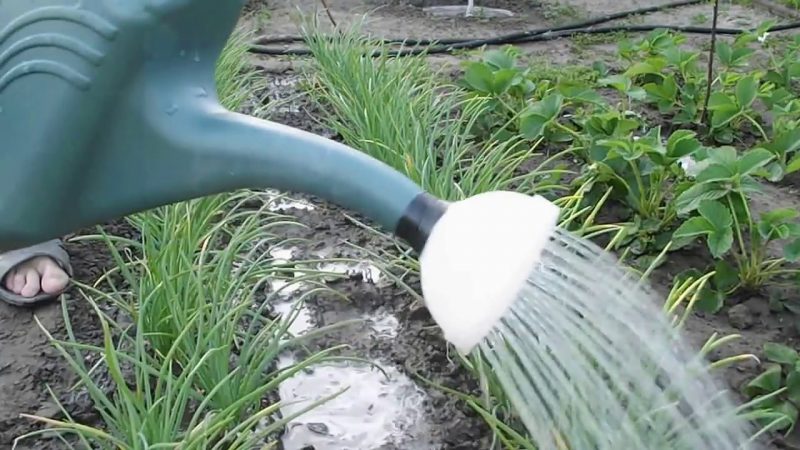
If there was a lot of precipitation in winter, when the snow melts, the beds are saturated with moisture in sufficient quantities.Therefore, the need to moisten the soil in spring is minimal. Watering is required only when hot weather is established. They are carried out as the soil dries out. Watering is stopped 20 days before harvesting.
Loosening and thinning
After each watering or rain, the soil is loosened, preventing the formation of an earthen crust. Weeds are removed simultaneously with loosening. If the crop plantings are strongly thickened, thinning is carried out, removing weaker shoots.
Top dressing
The first spring feeding is carried out after the beds are freed from the covering material. As soon as 3-4 leaves appear on the seedlings, the beds are watered with a urea solution (20 g per 10 l of water). The second feeding is performed during the period of turnip formation.
Organic and mineral fertilizers alternate: ammofoska (20 g per 10 l of water), potassium nitrate (15 g per 10 l of water), wood ash (100 g per 10 l of water), chicken manure solution (the manure infusion is diluted with water in a ratio of 1: ten).
Important! Top dressing is applied only to moistened soil.
Pest and disease control
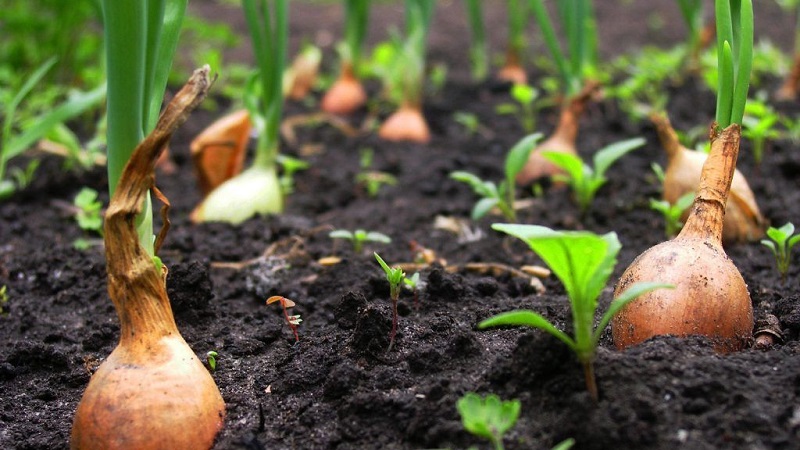
With the onset of spring, during the active growing season, the crop may undergo some diseases and pest infestations. Culture-specific diseases:
Powdery mildew - a fungal disease, the causative agent of which is transmitted through untreated planting material. The fungus develops in thickened plantings, with excessive watering. On the feathers, yellow spots appear in the form of a coating that resembles flour.
Gradually, the spots acquire a dirty lilac shade, become dense. The feathers droop, the heads are suspended in development. As a prophylaxis of the disease, the planting material is kept for 3 hours in a saturated pink solution of potassium permanganate, then 30 minutes in Baktofit. The affected leaves are sprayed with a 1% solution of copper sulfate, "Topaz", "Quadris".
Attention! Onion greens treated with chemicals are not suitable for human consumption.
Rust - fungal infection of onion leaves, characterized by the formation of copper-red growths with a fluffy surface. In the affected areas, the leaves turn black. The spores of the fungus remain in the soil after the removal of diseased plants, they tolerate frosts well, and in the spring they strike fresh greens.
To prevent the disease, the inoculum is heated at 40-50 ° C for 2 hours. The soil before planting is treated with a saturated solution of potassium permanganate, Bordeaux liquid. In the fight against rust fungicides "HOM", "Kaptan" are used.
Fusarium (bottom rot) spreads through untreated soil, plant debris. Infected leaves turn yellow and dry out. Pinkish mold appears on the necks of the turnips, the bottom and roots turn black, rot, and mucus oozes from the scales. For prophylaxis, seedlings are treated in a solution of "Fundazol". The beds are watered with Trichodermin.
The most common crop pests:
- Onion fly most often affects onions grown from seeds, especially thickened plantings. The parasites lay eggs in the leaf axils. The larvae attack the neck of the bulb, causing it to rot. For prophylaxis, tobacco dust, wood ash, dry mustard are scattered on the beds. Carrots are planted around the beds to scare off the pest.
- Tobacco thrips feeds on the sap of the leaves, from which they dry out. "Turnips" stop growing. To combat insects, the preparations "Aktara", "Karate" are used.
- Onion moth larvae eat away the pulp of greens. To scare them away, the soil is sprayed with a solution of "Entobacterin", "Lepidocide". With a small number of pests, the soil in the aisles is watered with an infusion of wormwood (3 kg per bucket of hot water is insisted for a day) or calendula (with the same recipe).
Conclusion
The podzimny planting of family onions has a number of advantages over the spring planting of a crop: getting early greens, minimal care in spring, and high yields. For planting, the main thing is to choose the right frost-resistant variety and observe the planting time.In this case, the culture will delight you with useful greens even in the conditions of the Urals and Siberia.